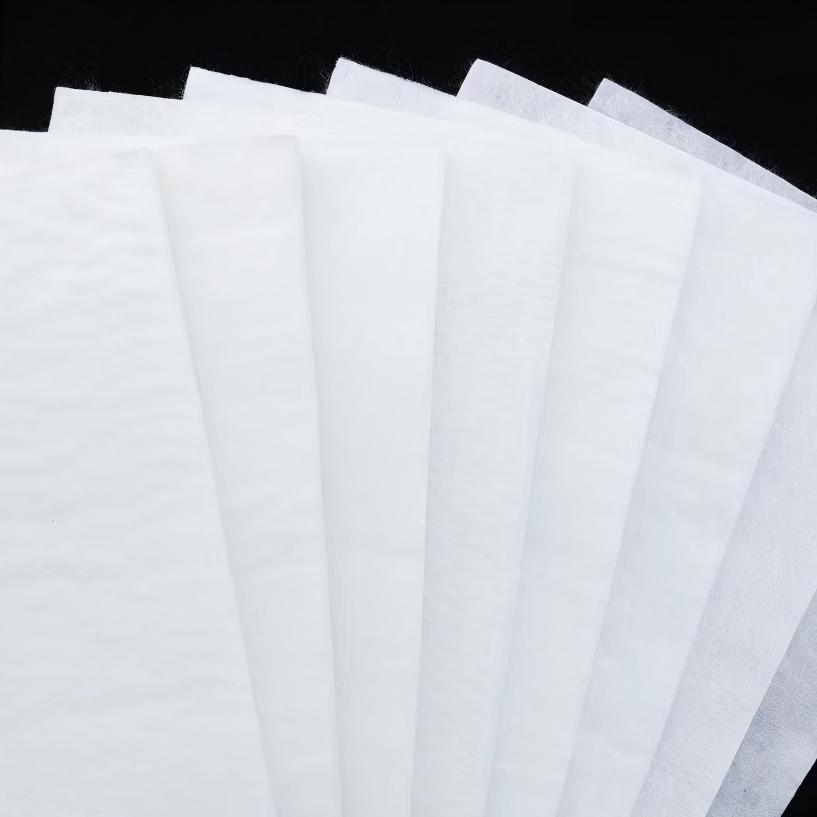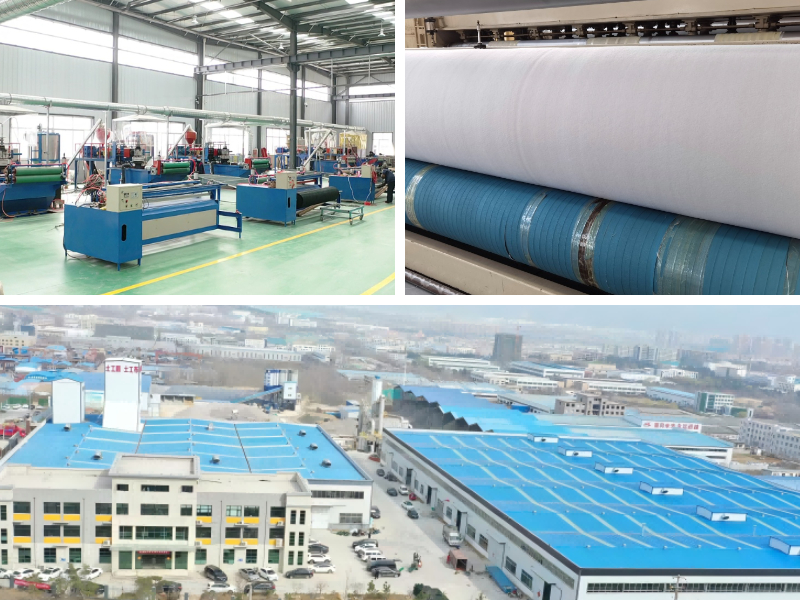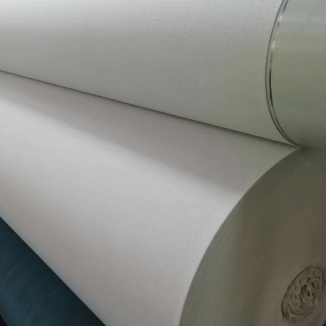Geotextile Barrier
1. Low comprehensive cost: Although the unit price of materials is higher than that of clay, it does not require a large amount of earthwork excavation/transportation, reducing construction labor costs by 40%, and reducing maintenance costs in the later stage
2. Lightweight: The weight per unit area is only 1/500 of concrete, which can reduce structural loads and save engineering space
3. Environmental Protection: Synthetic fibers are recyclable, while natural fibers are biodegradable; Construction without dust and waste, with minimal ecological damage to the surrounding area
4. Good uniformity: Factory standardized production, performance error<5%, avoiding the problem of "large on-site quality fluctuations" of traditional materials
Product Introduction:
Geotextile Barrier is a porous and permeable geosynthetic material made of synthetic or natural fibers. Its main function is to control fluids (water, pollutants) or solid particles (soil, sand, and gravel) in geotechnical, environmental, and civil engineering through physical isolation, filtration, drainage, or reinforcement, protecting the stability of engineering structures and reducing environmental risks. The core difference between it and ordinary fabrics is that its design needs to meet engineering grade mechanical properties, weather resistance, and environmental adaptability, rather than just textile functions.
Core Definition
Geotextile barrier is a textile geosynthetic material with specific engineering functions, processed through weaving, non-woven (needle punching, thermal bonding, etc.), machine weaving and other processes. It can act as a "barrier" in different engineering scenarios: it can isolate different media (such as soil and sand), prevent the migration of harmful pollutants, filter impurities in water bodies, and enhance the bearing capacity of foundations. It is one of the key components in modern civil engineering to replace traditional materials (such as clay and concrete).
According to material and function, they are commonly classified as follows:
Classification based on specific types and core characteristics
Material:
Synthetic fibers: mainstream types such as polypropylene (PP) and polyester (PET), acid and alkali resistant, corrosion-resistant, and have a long lifespan (10-50 years)
Natural fibers such as coconut shell fiber and flax are biodegradable and suitable for short-term ecological restoration projects (such as temporary slope protection)
Workmanship
Non woven geotextile: random arrangement of fibers, high porosity (70% -90%), excellent filtration and drainage performance, and low cost
Woven/woven geotextile: regular interweaving of fibers, high tensile strength (up to 100kN/m or more), strong tear resistance, suitable for reinforcement scenarios
Key features
The performance design of geotextile barriers revolves around "engineering applicability", and the core characteristics can be summarized as the following four points:
1. Multi functional integration: A single material can simultaneously achieve the triple functions of "isolation+filtration+drainage". For example, in roadbed engineering, it can isolate the roadbed soil from the cushion sand and gravel (preventing soil particles from seeping into the sand and gravel and blocking the pores), filter rainwater (preventing impurities from entering the drainage system), and discharge accumulated water inside the roadbed (reducing soil moisture content and avoiding roadbed settlement).
2. Stable physical performance:
High mechanical strength: The tensile fracture strength of synthetic fiber products can reach 10-150kN/m, which can withstand soil self weight, vehicle load or soil compaction pressure, and is not easy to tear or deform;
Strong weather resistance: resistant to ultraviolet (UV) radiation, high and low temperatures (-30 ℃ to 70 ℃), acid and alkali corrosion (stable performance within pH range of 3-11), and not easily aged after long-term use in outdoor or underground environments.
3. Controllable permeability: By adjusting the fiber density and pore size, it is possible to achieve "high permeability" (such as geotextiles for drainage, with a permeability coefficient greater than 1 × 10 ⁻ m/s) or "low permeability" (such as anti-seepage auxiliary barriers, with a permeability coefficient less than 1 × 10 ⁻ m/s), meeting the water control needs of different projects.
4. Construction convenience: The products are mostly roll shaped (width 2-6m, length 50-100m), lightweight (100-500g per square meter), and can be laid without the need for large equipment; And it can be cut and spliced according to the engineering size, suitable for complex terrain (such as slopes and curved foundations), with a construction efficiency 3-5 times higher than traditional clay barriers.
Product Parameters:
project | metric | ||||||||||
Nominal strength/(kN/m) | |||||||||||
6 | 9 | 12 | 18 | 24 | 30 | 36 | 48 | 54 | |||
1 | Longitudinal and transverse tensile strength / (kN/m) ≥ | 6 | 9 | 12 | 18 | 24 | 30 | 36 | 48 | 54 | |
2 | Maximum elongation at maximum load in longitudinal and transverse directions/% | 30~80 | |||||||||
3 | CBR top penetration strength /kN ≥ | 0.9 | 1.6 | 1.9 | 2.9 | 3.9 | 5.3 | 6.4 | 7.9 | 8.5 | |
4 | Longitudinal and transverse tearing strength /kN | 0.15 | 0.22 | 0.29 | 0.43 | 0.57 | 0.71 | 0.83 | 1.1 | 1.25 | |
5 | Equivalent aperture O.90(O95)/mm | 0.05~0.30 | |||||||||
6 | Vertical permeability coefficient/(cm/s) | K× (10-¹~10-), where K=1.0~9.9 | |||||||||
7 | Width deviation rate /% ≥ | -0.5 | |||||||||
8 | Unit area mass deviation rate /% ≥ | -5 | |||||||||
9 | Thickness deviation rate /% ≥ | -10 | |||||||||
10 | Thickness coefficient of variation (CV)/% ≤ | 10 | |||||||||
11 | Dynamic perforation | Puncture hole diameter/mm ≤ | 37 | 33 | 27 | 20 | 17 | 14 | 11 | 9 | 7 |
12 | Longitudinal and transverse fracture strength (grab method)/kN ≥ | 0.3 | 0.5 | 0.7 | 1.1 | 1.4 | 1.9 | 2.4 | 3 | 3.5 | |
13 | Ultraviolet resistance (Xenon arc lamp method) | Longitudinal and transverse strength retention rate% ≥ | 70 | ||||||||
14 | Ultraviolet resistance (fluorescence UV lamp method) | Longitudinal and transverse strength retention rate% ≥ | 80 | ||||||||
Product Applications:
1. Traffic engineering: roadbed and pavement protection
Application areas: subgrade bottom, between pavement base and cushion layer, slope surface;
Core role:
Isolation: prevent the infiltration of roadbed soil (fine particles) into the cushion layer sand and gravel, avoid blockage of cushion layer pores, and ensure smooth drainage;
Reinforcement: Enhance the overall stiffness of the roadbed, disperse vehicle loads, and reduce uneven settlement of the roadbed (especially in soft soil foundation sections, settlement can be reduced by 30% -50%);
Protection: Geotextile is laid on the slope (often combined with vegetation) to prevent soil erosion caused by rainwater erosion and avoid slope collapse.
2. Water conservancy engineering: embankment and river management
Application areas: auxiliary anti-seepage layer for dams, riverbank slopes, and drainage body wrapping;
Core role:
Anti seepage assistance: used in conjunction with HDPE film as a "protective layer" to prevent the geomembrane from being punctured by sharp stones, while filtering out seepage and reducing the risk of dam leakage;
Bank slope protection: Geotextile is laid on the bank slope of the river, covering the soil and fixing vegetation to resist water erosion and protect the ecological environment of the riverbank (such as the bank slope stability project in urban black and odorous water treatment).
3. Environmental Engineering: Remediation of Polluted Sites and Landfilling of Waste
Application areas: landfill lining, contaminated soil barrier layer, leachate treatment system;
Core role:
Pollutant isolation: As a "vertical/horizontal barrier", it prevents landfill leachate (containing heavy metals and organic matter) from infiltrating into groundwater bodies, or prevents pollutants in polluted soil from spreading to surrounding clean areas;
Filtration and purification: In the leachate collection system, suspended particles are filtered to prevent blockage of drainage pipes and improve the efficiency of leachate treatment.
4. Construction Engineering: Foundation and Excavation Support
Application areas: Soft soil foundation reinforcement, foundation pit dewatering filter layer, basement exterior wall anti-seepage;
Core role:
Foundation reinforcement: In combination with sand and gravel piles and plastic drainage boards, it accelerates the drainage consolidation of soft soil foundation and improves the bearing capacity of the foundation (such as high-rise buildings and industrial plant foundation treatment);
Foundation pit protection: Geotextile is laid on the slope of the foundation pit, combined with soil nail walls or anchor rods to enhance the stability of the slope. At the same time, soil particles during the precipitation process are filtered to avoid ground settlement around the foundation pit.
5. Agriculture and Ecological Engineering: Soil and Water Conservation and Vegetation Restoration
Application areas: terraced slopes, mine reclamation areas, and highway green belts;
Core role:
Soil and water conservation: Laying geotextiles on terraced fields in arid areas to reduce soil moisture evaporation; Prevent rainwater from washing away soil and maintain soil fertility in rainy areas;
Vegetation restoration: During mining reclamation, geotextiles can fix the surface soil, provide a stable environment for plant seed germination, and prevent seeds from being washed away by rainwater, accelerating the ecological restoration process.
In summary, geotextile barriers are a multifunctional, efficient, and economical modern engineering material. It plays an irreplaceable role in the four core functions of "isolation, filtration, drainage, and reinforcement" through its unique physical characteristics, and has become one of the key technical means to ensure the safety, durability, and economy of various civil engineering projects.













